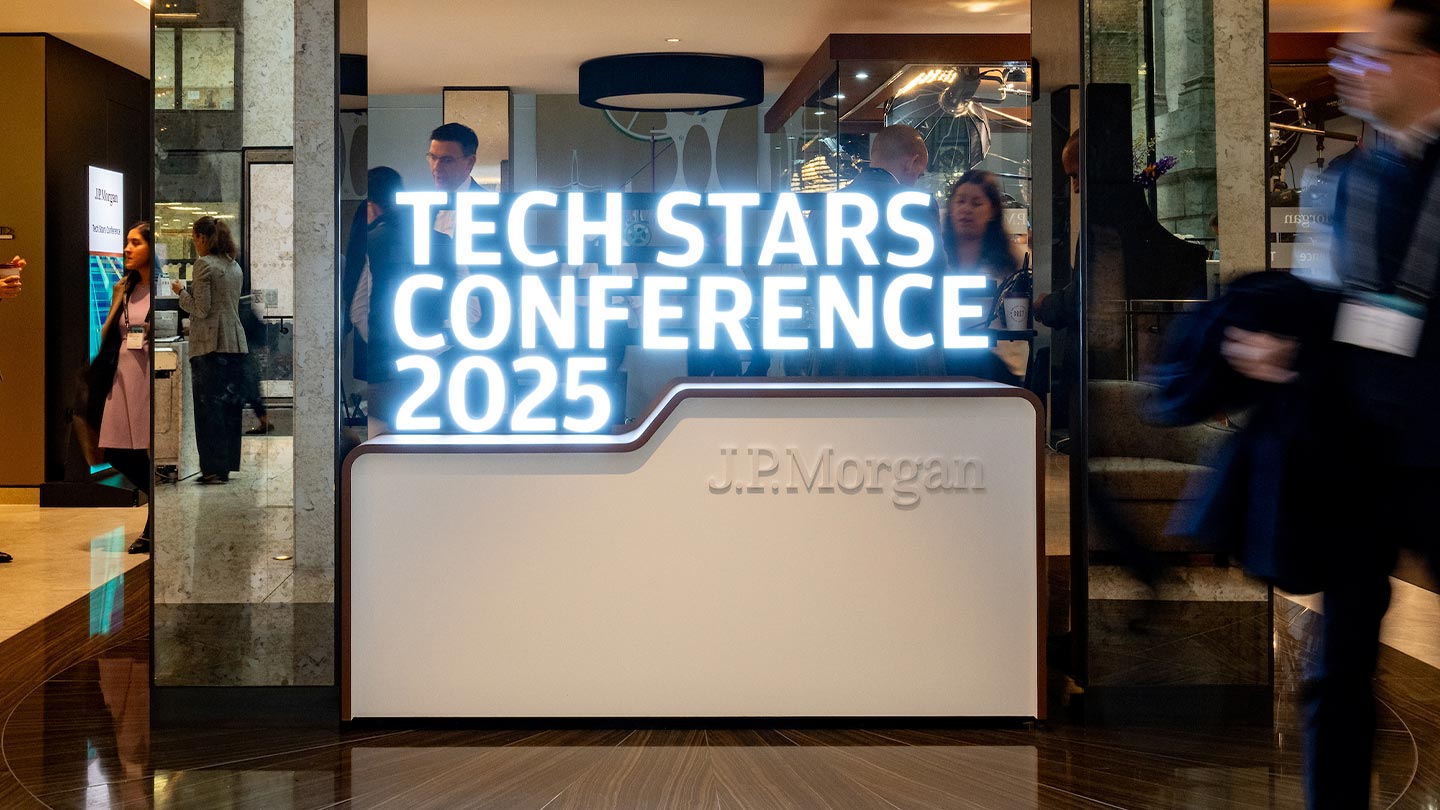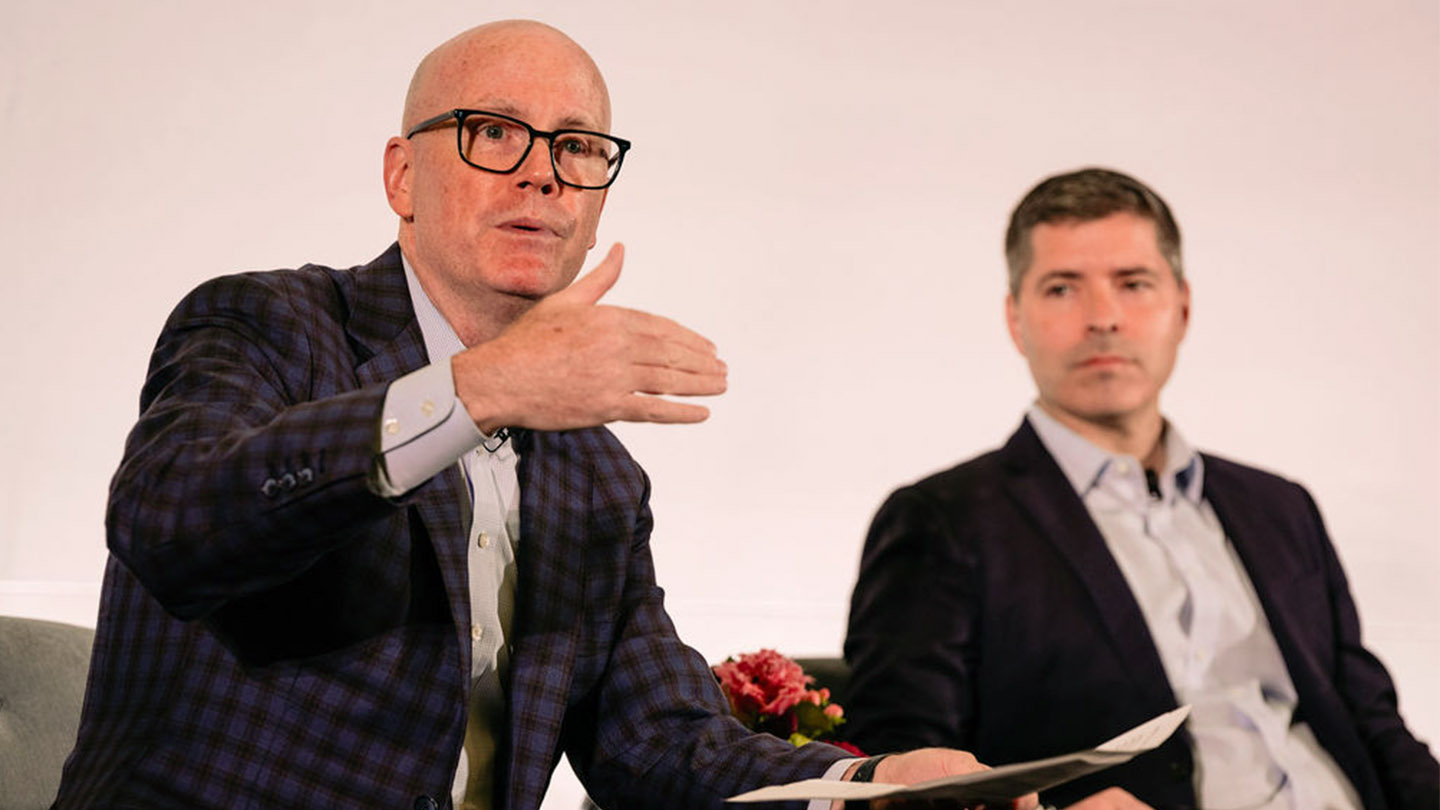J.P. Morgan is a leader in technology investment banking with a team of industry experts located in San Francisco, New York, Boston, London, Hong Kong and Singapore.
The firm offers a complete range of strategic banking services, strengthened by deep industry knowledge and integrated solutions across the technology ecosystem including hardware, semiconductors, semi-cap equipment and more. With a proven track record in the technology industry, the firm advises clients ranging from start-ups to corporates on achieving their M&A and capital raising goals.
Industry leading conferences

Tech Stars 2025
How the industry’s leading minds are shaping the future of tech
J.P. Morgan’s 13th Tech Stars Conference brought together innovators, investors and industry leaders to explore what’s next in AI, quantum computing and more.

Global Technology, Media and Communications Conference
Learn more about our key investor event for the technology, media and communications industries, featuring sectors such as hardware, semiconductors, semi-cap equipment, media, internet and more.
Delivering complete technology investment banking solutions to meet your scale and needs

Investment Banking
Providing investment banking solutions, including M&A, capital raising and risk management, for a broad range of corporations, institutions and governments
M&A
Bespoke M&A solutions on a global scale.
Capital Markets
Holistic coverage across capital markets.
Mid-Cap Investment Banking
Discover how our team drives growth for local clients with tailored advisory solutions and industry expertise.
Corporate Finance Advisory
Corporate Finance Advisory (“CFA”) is a global, multi-disciplinary solutions team specializing in structured M&A and capital markets that is focused on differentiating J.P. Morgan’s Investment Banking services.
Director Advisory Services
Building boardrooms across the globe through governance, composition and talent.

Navigating the Future
A strategic, long-term look at the transformative economic and societal impact of artificial intelligence, the future of energy and exciting innovations in healthcare. Amid rapid change, 'Navigating the Future' provides insights for industry leaders planning for the decade ahead.

Is AI already impacting job growth?
AI is poised to displace jobs, with some industries more at risk than others. Is the paradigm shift already underway?
Key insights from the Technology, Media and Communications Conference
Discover how AI, 5G, cloud adoption, and cybersecurity are shaping the future of these sectors.
Dealmaking spotlight: Key trends driving growth in 2025
Driving into 2025: The Future of Electric Vehicles
The J.P. Morgan Research team explores the rise of the electric vehicle and what the industry will look like by 2025.
Unpacked: Blockchain
What is blockchain and how is it changing the world we live in? Learn all about blockchain technology in this simple explainer video.
Unpacked: IPO
What is an IPO and how does it work? Explore this major milestone in a company’s journey where its shares are listed and sold in a public exchange.
Some J.P. Morgan products and services may not be available in certain regions. Please consult your J.P. Morgan representative to learn more about the products and services available to you.
This material (including market commentary, market data, observations or the like) has been prepared by personnel in the Investment Banking Group of JPMorgan Chase & Co. It has not been reviewed, endorsed or otherwise approved by, and is not a work product of, any research department of JPMorgan Chase & Co. and/or its affiliates (“J.P. Morgan”).
Any views or opinions expressed herein are solely those of the individual authors and may differ from the views and opinions expressed by other departments or divisions of J.P. Morgan. This material is for the general information of our clients only and is a “solicitation” only as that term is used within CFTC Rule 1.71 and 23.605 promulgated under the U.S. Commodity Exchange Act.
RESTRICTED DISTRIBUTION: This material is distributed by the relevant J.P. Morgan entities that possess the necessary licenses to distribute the material in the respective countries. This material is proprietary and confidential to J.P. Morgan and is for your personal use only. Any distribution, copy, reprints and/or forward to others is strictly prohibited.
This material is intended merely to highlight market developments and is not intended to be comprehensive and does not constitute investment, legal or tax advice, nor does it constitute an offer or solicitation for the purchase or sale of any financial instrument or a recommendation for any investment product or strategy.
Information contained in this material has been obtained from sources believed to be reliable but no representation or warranty is made by J.P. Morgan as to the quality, completeness, accuracy, fitness for a particular purpose or noninfringement of such information. In no event shall J.P. Morgan be liable (whether in contract, tort, equity or otherwise) for any use by any party of, for any decision made or action taken by any party in reliance upon, or for any inaccuracies or errors in, or omissions from, the information contained herein and such information may not be relied upon by you in evaluating the merits of participating in any transaction. All information contained herein is as of the date referenced and is subject to change without notice. All market statistics are based on announced transactions. Numbers in various tables may not sum due to rounding.
J.P. Morgan may have positions (long or short), effect transactions, or make markets in securities or financial instruments mentioned herein (or options with respect thereto), or provide advice or loans to, or participate in the underwriting or restructuring of the obligations of, issuers mentioned herein. All transactions presented herein are for illustration purposes only. J.P. Morgan does not make representations or warranties as to the legal, tax, credit, or accounting treatment of any such transactions, or any other effects similar transactions may have on you or your affiliates. You should consult with your own advisors as to such matters.
The use of any third-party trademarks or brand names is for informational purposes only and does not imply an endorsement by JPMorgan Chase & Co. or that such trademark owner has authorized JPMorgan Chase & Co. to promote its products or services.
J.P. Morgan is the marketing name for the investment banking activities of JPMorgan Chase Bank, N.A., J.P. Morgan Securities LLC (member, NYSE), J.P. Morgan Securities plc (authorized by the Prudential Regulation Authority and regulated by the Financial Conduct Authority and the Prudential Regulation Authority), J.P. Morgan SE (Authorised as a credit institution by the Federal Financial Supervisory Authority (Bundesanstalt für Finanzdienstleistungsaufsicht, BaFin) and jointly supervised by the BaFin, the German Central Bank (Deutsche Bundesbank) and the European Central Bank (ECB)), J.P. Morgan Securities Australia Limited (ABN 61 003 245 234/AFS Licence No: 238066 and regulated by Australian Securities and Investments Commission) and their investment banking affiliates. J.P. Morgan Securities plc is exempt from the licensing provisions of the Financial and Intermediary Services Act, 2002 (South Africa).
For Brazil: Ombudsman J.P. Morgan: 0800-7700847 / ouvidoria.jp.morgan@jpmorgan.com
For Australia: This material is issued and distributed by J.P. Morgan Securities Australia Limited (ABN 61 003 245 234/ AFS Licence No: 238066) (regulated by ASIC) for the benefit of “wholesale clients” only. This material does not take into account the specific investment objectives, financial situation or particular needs of the recipient. The recipient of this material must not distribute it to any third party or outside Australia without the prior written consent of J.P. Morgan Securities Australia Limited.






